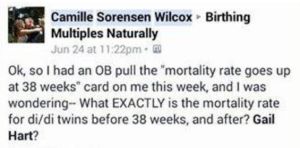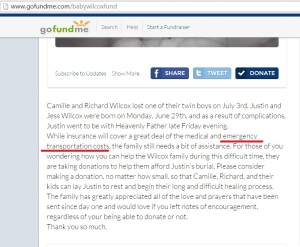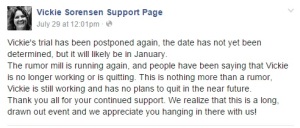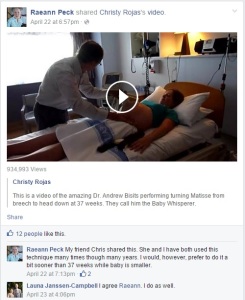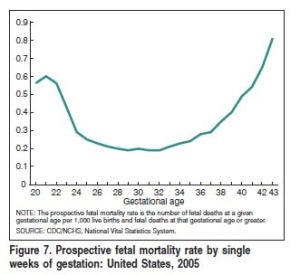Vickie Sorensen was found guilty of Manslaughter after the jury deliberated for four hours. The spectrum has thankfully covered the trial in depth, including testimony that brought some new facts to light about the events that transpired. Some of the more shocking revelations:
Although Vickie Sorensen and her daughter Camille Wilcox were not adequately trained to deal with respiratory distress in newborns, someone at the birth WAS properly trained and willing to help: the grandmother of the deceased was a former NICU nurse. She was there and wanted to assist with CPR but the correct equipment was not usable so she could not help her grandchild. Sorensen didn’t have the correct size of equipment to use on newborns.
”
Thornton was in the waiting room of the birthing center when she heard a loud crash coming from the birthing suite, she recounted for the jury. When she went to investigate, Thornton found Sorensen putting drops into the mouth of the baby who was not breathing. She said she switched into nurse mode and asked Sorensen for a suction to remove excess fluids from the lungs to help the baby breathe, but the midwife handed her a device much too large for the preemie. She then asked for a bag valve mask to force oxygen into the baby’s lungs, but Thornton said Sorensen was allegedly unable to provide working equipment.
“I’ve always been able to save babies, but I couldn’t save my grandbaby,” Thornton said as she recounted feeling shocked as the paramedics took the child.”
The proper training is not always adequate if you lack the proper equipment, which is why hospitals and real birthing centers are heavily regulated to protect patients from missing or faulty equipment. This highlights something mind boggling about Utah laws. The birthing suites that direct entry midwives use are completely unregulated. There is no state oversight for infection control or proper equipment, which in this case could have saved this child’s life. The health department is not able to inspect or discipline direct entry midwives that run unsafe birthing suites. No one is making sure that babies are being born in safe or even simply hygienic circumstances.
Another shocker to me:
The investigation was not a standard practice in the home birth death of an infant, it happened because of a discrepancy in the death certificate. There is no standard that ensures investigation after a baby dies in a planned out of hospital birth.
“Cedar City Police Detective Mike Bleak said he didn’t begin looking into the infant’s death with the intent of launching a criminal investigation. Bleak, who also serves as an investigator for the state medical examiner, was asked to sort out a discrepancy in paperwork as the state had received a record of burial dated as Dec. 26 while the death certificate was dated as Dec. 27 — implying that an illegal burial had been conducted, Bleak explained.
With the parents still with the surviving child in the neonatal intensive care unit (NICU) at Dixie Regional Medical Center, Bleak met with Sorensen to determine what happened.”
Sorensen proceeded to act very suspiciously, which spurred on the criminal investigation. A more clever sort of liar may have been able to get away with it.
Vickie Sorensen is one of the most experienced direct entry midwives in Utah with 30 years of experience. She came highly recommended by virtually everyone in the community. Yet when you read her testimony, it becomes clear that she had so many dangerous gaps in the needed knowledge for delivering babies safely. If you think you can protect yourself or your child by researching the “right” midwife, you are wrong. The problem is the direct entry midwife “credential” itself, its completely inadequate for delivering babies safely. Even the most highly trained direct entry midwives seem to lack so much basic education on health care practices.
The time line of this case is alarming as well.
The death happened in 2012.
The arrest was in 2014.
The trial happened in 2016.
Four years passed between the death and the trial, and in the interim Vickie Sorensen was fully supported as a practicing midwife by the Utah Midwife Organization (UMO). She raised 50,000$ for her bail from UMO/home birth community. For four years Sorensen was allowed to practice as a midwife legally, and with no sanctions from UMO. If your child is injured or killed by a negligent direct entry midwife, you may find yourself waiting years before anything can be done, because it has to reach the level of criminality to be punished. By contrast, physicians and nurse practitioners that behave negligently have to answer to licensing bodies that actually revoke licenses and discipline members, and they also have malpractice insurance to compensate those who were harmed or surviving family members. Direct entry midwives are against any measures that restrict practices or require insurance in the event of negligence.
The last thing people need to know is that vickie has never been remorseful about what happened. She doesn’t understand what she did wrong. In fact, she denied that she apologized to the grandmother of the deceased for lacking proper equipment. You can see the shamelessness of her pride in her facebook posts about the trial as well.
Well, there it is. Our truth has finally been told. Vickie testified today, and she was brilliant, charismatic and engaging on the stand. As she gently explained to the jury the procedure for neonatal rescucitation, her knowledge and passion for mothers and babies was evident.
Vickie clearly believes she should still be delivering babies. There is nothing that can convince her that her beliefs about childbirth are not realistic, even witnessing death that happened directly as a result of it, or the other close calls that happened, and later losing her own grandchild, isn’t enough to inspire humility in her. It is terrifying, to be honest.
Today, the prosecution parades the last of their witnesses (as long as there aren’t any more delays!). We look forward to telling our side of the story tomorrow.
They are “parading” witnesses, such as the family that aches for the child that could have been safely born and alive right now, and the doctors and EMTs that knew that they were seeing a totally pointless tragedy unfold in front of them. This kind of attitude towards death and maiming seems to be the norm for lay midwives like Sorensen. If you are worried about future tragedies unfolding please contact your legislators to coordinate action on behalf of these children who cannot speak out for themselves.


